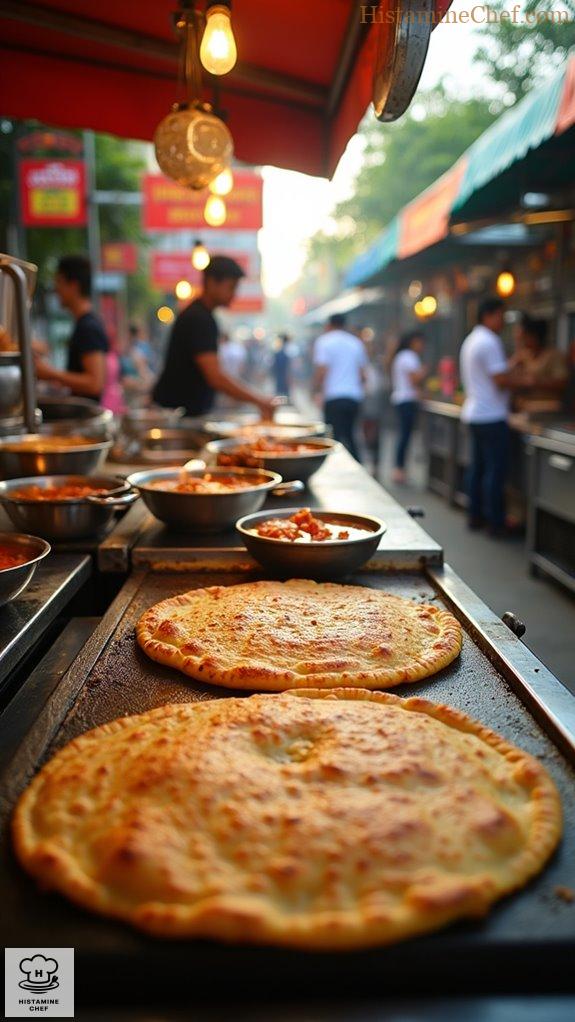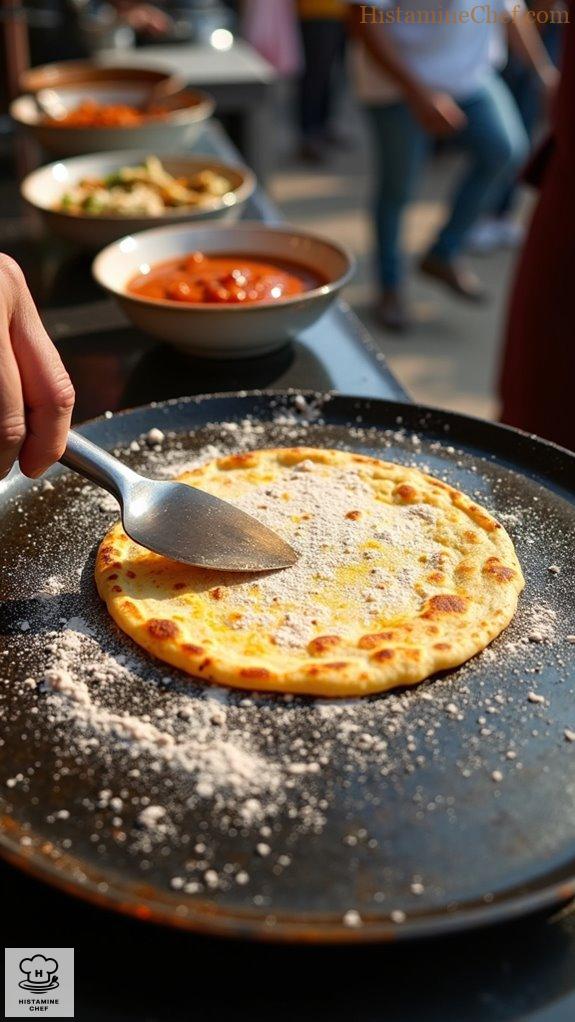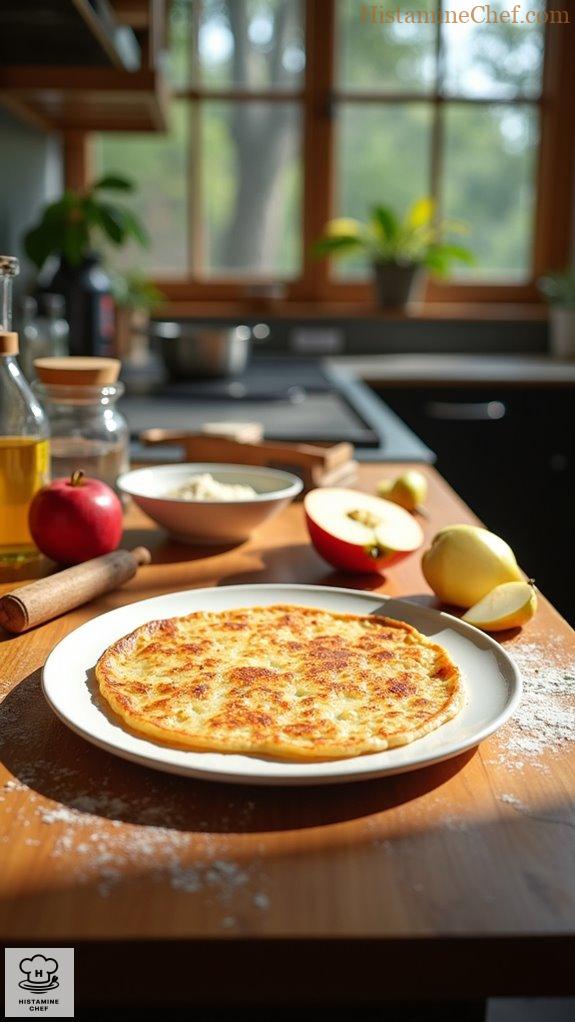Ever wondered how to savor Singapore’s roti prata without worrying about histamine? I’ve crafted a homemade version that’s not only delicious but kinder to your body. Using just spelt flour, coconut oil, and water, I roll and flip this crispy treat on a hot griddle while avoiding common triggers. Pair it with fresh fruits instead of curry, and you’ve got a guilt-free snack! Stick around, and I’ll share tips to perfect your own roti prata adventure!
Cultural Hub of Singapore

Singapore’s street food culture is a vibrant tapestry reflecting its multicultural heritage, where Malay, Chinese, Indian, and Peranakan influences converge to create an extraordinary culinary environment.
This fusion is most tantalizingly on display in the region’s beloved hawker centers, which have become emblematic of Singapore’s food scene.
The origins of street food in Singapore date back to the early 19th century, when immigrants settled in the bustling port city, bringing their gastronomic traditions with them. Vendors began to serve various dishes from makeshift stalls, catering to the diverse palate of the population.
One iconic street food item that showcases this blend is Roti Prata, an Indian-influenced flatbread that’s often served with curry. This dish, characterized by its flaky texture and crispy exterior, is a reflection of the city’s culinary evolution over the years.
Today, hawker food stalls continue to thrive, offering affordable and delicious meals to locals and tourists alike, while preserving the rich history of communal dining and street food culture that defines Singapore.
Flipped on a Hot Griddle

Street vendors expertly prepare Homemade Roti Prata on a hot griddle by first rolling out a ball of dough into a thin, delicate circle.
They then dab a bit of oil on the surface and fold the edges inwards several times, creating layers.
Once the dough is sufficiently layered, it’s flattened again and placed on the preheated griddle, where it sizzles until golden brown.
The vendor flips the roti multiple times, ensuring a crisp exterior and a soft, fluffy interior.
As the roti cooks, vendors often serve it with a side of curry or sugar for dipping, enhancing the dish’s flavor profile.
Ingredients:
- 2 cups all-purpose flour
- 1 cup water
- 2 tbsp coconut oil
- 1 tsp salt
- 1 tbsp sugar
- 1 tbsp ghee or butter
- Curry sauce for dipping (optional)
- Sweetened condensed milk for serving (optional)
Cooking Steps:
- Combine flour, salt, and sugar.
- Gradually add water and mix.
- Knead until smooth; rest dough.
- Divide dough into small balls.
- Flatten each ball, add oil.
- Fold edges to form layers.
- Cook on hot griddle, flipping.
- Serve with curry or sugar.
Making Dough With Minimal Ingredients

To make homemade Roti Prata, start by mixing together 2 cups of wheat flour with a pinch of salt and water to form a soft, pliable dough. Knead the dough for about 10 minutes and let it rest for at least 30 minutes.
When ready, divide the dough into small balls, flatten them, and smear with a little butter for layered texture. Roll out each piece as thinly as possible, and then fold or crinkle them before frying on a hot skillet with more butter or oil until golden brown and crispy.
Serve warm with a side of curry or sugar for dipping.
- Use wheat flour instead of alternatives.
- Short resting time for dough.
- Knead dough more thoroughly.
- Monitor skillet temperature closely.
- Adjust for desired crispiness.
- Serve with tolerated sauces.
- Use butter for layering.
Low Histamine Variation of Roti Prata

Street food often contains high histamine ingredients, making it a risky option for those with histamine intolerance. Many street foods also involve processed or fermented components, which typically score high on the SIGHI list, aggravating symptoms. This is further complicated by the fact that certain cooking methods can also lead to increased histamine levels in food.
As a result, individuals with histamine sensitivity must carefully monitor their food choices to avoid reactions. Eating street food like Roti Prata can be problematic for those with histamine intolerance, primarily due to the potential presence of restricted ingredients and cooking methods that can elevate histamine levels.
Ingredients like certain flours and spices used in traditional recipes may be high in histamine or liberators, as outlined in the SIGHI list. Additionally, food preparation in external environments increases the likelihood of contamination with histamine-rich foods. This combination can make enjoying popular street food an uncomfortable experience for those sensitive to histamines.
To make a low histamine variation of Roti Prata at home, follow these instructions:
- Replace regular flour with spelt flour or gluten-free flour as needed.
- Use fresh yeast instead of any aged or dried yeast variants.
- Verify all oils used are olive oil or coconut oil, avoiding other oils.
- Omit any ingredients containing added spices like cumin, curry, or chili.
- Avoid any fermented or aged dairy products, using only allowed fresh dairy.
- Prepare the dough fresh without prolonged rising times to reduce histamine.
- Cook immediately after preparing the dough, avoiding storage periods before cooking.
- Serve with fresh fruits like apple or pear instead of traditional sauces.
- Keep all cooking utensils and surfaces clean to prevent cross-contamination.
- Enjoy the Roti Prata fresh and hot, minimizing time between cooking and serving.
Cooking low-histamine dishes requires attention to vinegar alternatives, as certain vinegars can elevate histamine levels in food. Proper ingredient substitutions and mindful cooking methods can help create delicious, safe recipes for those with histamine intolerance.
Video Summary
Roti Prata originated in the Indian Muslim community in Southeast Asia. In this video, we’ll explore two versions of this beloved dish: the authentic street version and a home-cooked, low histamine variation.
Street vendors start by preparing a dough with all-purpose flour, oil, and salt. They knead the dough until smooth, then let it rest for about two hours, allowing the gluten to relax. The vendors then divide the dough into small balls. Each ball is flattened with the palm and stretched with fingers, creating a thin layer. They’re then folded and flattened again before frying.
A hot, well-oiled skillet is essential for cooking. The result? A crispy, flaky roti prata served often with curry.
Now, let’s shift to the home low histamine version. Start with gluten-free flour instead of all-purpose flour. Mix it with water and allow it to rest, similar to the original. Use coconut oil for frying. Be sure not to add salt, as it can be a trigger. The goal is to achieve the same flaky texture.
When it comes to cooking, use a non-stick skillet with oil. Observe the golden color and crispiness as it cooks. Serve your low histamine roti prata with a simple fruit syrup made from allowed fruits to keep it gentle on your gut.
The final dish is light, crispy, and deliciously satisfying. For the full recipe and more tips, click the link in the description below.


Leave a Reply